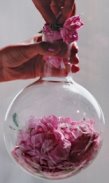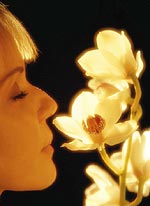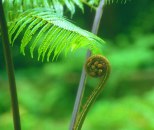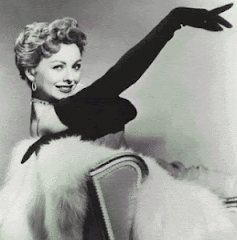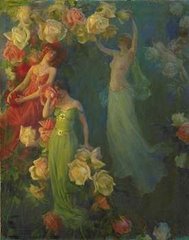I asked the perfumer Michael Storer for an interview and I'm so happy that he liked the idea
You can read my review of his perfumes at
this post.
Here is my interview with Michael Storer:
What inspired you to become a perfumer?
I’m 57 years old now, so this story goes back many, many years. I remember vividly when I was only five that my greatest desire for a birthday present was a bunch of eye droppers and bottles. (My requests were always a puzzlement to my parents). Of course, at that time I had absolutely no idea what I wanted to put in them. I just knew I wanted lots of them. My mother bought me about ten bottles and droppers from Owl Drugs.
I have always been talented in the fine arts and at the same time natural sciences, but was really torn between the two very different fields. I started with music lessons when I was in fourth grade and have always kept up with music. I took out my first subscription to Scientific American when I was thirteen. When I was in high school, through the 1960’s, I became interested in drawing and painting. My mother was a painter. I also discovered theater and was active in school plays. When not studying, I would go to the California State Library and read books on organic chemistry. I was particularly interested in chemicals that smelled and made copious notes about them and what they smelled like.
My mother had very few fragrances on her dresser, but I remember small bottles of such things as one shaped like a torso with a pink top called Shocking, another one, Balenciaga, that my father had given her in a beautiful heavy cut crystal bottle with glass stopper and a third, which she always said was her favorite, Quelques Fleurs. I was totally intrigued with might be in those bottles that made them smell so good. Wanting to pursue the matter, I talked my mom into taking me to the chemistry department at Sacramento State College. Somehow, being the great talker she was, she persuaded them to give me samples of about eight or ten organic chemicals I wanted. I remember using sulfuric acid to make my first ester of benzyl alcohol and acetic acid to produce benzyl acetate, a valuable fruity, ylang ylang type of odor. I had ordered other items from Eastman Kodak Chemicals including phenethyl alcohol, a rose note, some aldehydes and Musk Xylene. In those days restrictions on sales were much less severe so I was able to order as a teenager. I concocted my first perfume for my mother. I don’t remember what it smelled like; I’m sure it wasn’t anything too nice, but she dutifully wore it.
When I got to college, theater and music took precedence and I did nothing more with fragrance for many years. I eventually left home at nineteen and found myself traveling all over Europe, which I fell in love with, having only lived in suburban northern California heretofore. I sort of stumbled into acting in television commercials and photo modeling and was very lucky to be successful at this for many years both in Europe and Hollywood.
At one point, after a breakup from a long relationship, I moved to a small place on Venice Beach. I discovered a guy who was selling very fine essential oils and absolutes. I bought a number of them and also went to an aromatherapy seminar he recommended. There I smelled ambroxan, ambrette seed, tonka and a lot of other things and began a small collection. I had a dream to sell an organic, all natural men’s cologne. This idea died quickly when I discovered there wasn’t a decent or affordable musk in the plant kingdom. Musk tincture was not an option as I don’t believe in harming animals this way.
Again perfumery went dormant for several years. Then a friend told me about a men’s fragrance he had found called
Gendarme, which was new on the market and I loved it. It was way ahead of its time, as it was the first transparent fragrance I had ever smelled. Of course, at the time I didn’t know the term, just that I really liked it. I found out that it was made in West Hollywood by an independent right near where I was living. With some help of the internet, I wrote the manufacturer a fan letter. It turned out to be Topper Schroeder. I visited with him and told him that I had the same dream to manufacture. He gave me encouragement. I dropped the subject again for about three years, but never forgot it.
Several years ago, as I was getting tired of show business and my work was slowing, I went into therapy as I was in a classic “mid-life crisis.” My wonderful therapist helped me to realize that manufacturing fragrances was really what I wanted to do. I had been left some money when my father died, so I had the means to start something. I went ahead and developed three scents. I conceived of them as being for men as I had little experience with women’s fragrances. Little did I know that women would like them, too.
Oh, by the way, I now have literally hundreds of bottles and droppers.
Your first idea was to make an all natural men's cologne but stopped with this idea because there wasn't a decent or affordable musk in the plant kingdom , if you would think the other way around could you name a natural compound that you consider to be irreplaceable by synthetics?I have never smelled a sandalwood substitute that really captures the real thing. Sandalwood as it used to be. At home when I was a kid we had a bottle of real sandalwood oil dating from probably the 1940's. Firmenich's "Sandalwood" doesn't hold a candle to it. Elements of sandalwood exist that are excellent, but not the whole odor profile. Others that come to mind are clary sage oil and absolute, labdanum, olibanum (frankincense). I haven't smelled a really good facsimile of benzoin either. They don't capture the depth. The same with balsam peru. I'm sure there are a lot more that I can't think of offhand. There are also some rose absolutes that still remain unique, even though inventing new substitutes is big business.
You've been a fashion model and actor, archived a master's degree in Fine Arts at UClA, painted and made constructional art and composed music. It seems like you really enjoy creating in all kinds of forms. Can you tell me if this had influence on your creation of fragrances?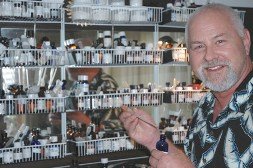
Yes, very much so. I love the process of having something in my head and giving birth to it into the world of reality. I guess I have a strong need to share what's inside me with the world. To bring something of beauty, of value. Something positive and something good about which I can say, "I did that." Just like everyone, I guess, I have a need to be excellent at something, to shine. Does that make me an egotist? Perfume manufacture captivates me because it challenges all my skills of visual design in conceptualizing and packaging. Also, the process of creating a fragrance is a lot like painting to me. Instead of a palette of colors you have an endless palette of smells to remember and to work with.
You made three wonderful men's fragrances, are you ever going to make a fragrance for women?
As we speak I'm continuing work refining a fragrance for women which I want to call Genviève. It's a floral concept I've wanted to do for a long time. Stepping into the world of women's fragrances is a bit daunting because I've worn men's fragrances and feel I know them better. What I'm making now will hopefully be a classic, elegant, retro-type multi-flower scent based on rose, violet and mimosa. I am exchanging e-mails with a bottle manufacturer right now which is designing me a Channel No. 5 style of crystal bottle with glass stopper for Genviève.
Which of your fragrances did you enjoy composing the most?
That's a tough question. I did hundreds of trials on all of them. I would probably say Monk was my favorite because I was going for something completely unique.
What was your idea behind Monk?
I got really tired of smelling "cool water this" and "fresh air that"... everything smells so ozonic (airy or watery) to me in the department stores. I thought others might be getting tired of this, too, and that the pendulum would swing back to a wider range of fragrances that preceded this trend, but with new materials and new twists. I created Monk actually with a particular chain of stores in mind which sells "goth" clothing and merchandise. It turned out that they thought the concept was too "religious" even though they specialize in demon T-shirts and vampire clothing! They ended up producing their own scent. So I lost out there. But I really wanted something for young people into the goth lifestyle. Once again I'm working on that theme with a leathery, smoky scent that I think fits that style of dress, tattoos and all. Certainly something better than Cool Water or what have you. That style of dress needs something edgy, metallic and dark... I'm still working on that theme as I think there is a market for it. And in general, I truly believe the watery melons will become passé soon for everyone, not just goths. I mean, isn't it getting boring already?
Do you have a personal favorite fragrance family and a favorite particular fragrance note?
I love leathers and coumarin. I dislike basil and tarragon notes. I love vanilla notes and musks... sandalwood and other smooth woods.. I like rose a lot. I think most people probably do. It's the queen of flowers. I love the smell of sweet peas. I wish I could figure out to make a fragrance exactly like a bouquet of sweet peas, but I haven't been successful yet. Another one of my favorites is carnations. I don't care for really green fragrances too much. I much prefer creamy, lactonic notes.
What is your favorite fragrance that you didn't create yourself and could you think of one fragrance that you wished you had created, which would it be and why?
Gendarme, by the independent Topper Schroeder. I think I mentioned him before. He created a fragrance that smells like a clean shower. It is an unusual fragrance in that it just stays squeaky clean. When wearing it I have had people ask me if I had just taken a shower. I don't know if you can find it in Europe or not, but it’s wonderful and since he brought it out in small boutiques here locally maybe 20 years ago, it has just continued to grow in popularity. As far as I know, he doesn't do any advertising for it. I wish I had invented that fragrance. I think it will remain a classic.
What is your favorite ingredient to work with (natural and/or synthetic) and about how many fragrance materials do you have in your fragrance organ?
I just counted roughly. I see that I have somewhere between 400 and 500. I'm surprised myself!
My favorites to work with are Genet absolute (also called broom absolute). Another one I use is Mimosa absolute. Tonka bean is another very luxurious ingredient that I like, as well as natural balsam of benzoin for a woody, vanilla-like note. Also patchouli, bergamot and clary are important naturals to me. Also angelica root is something I really love... and galbanum, too. I also love Javanol by Givaudan... a very long lasting, expensive and velvety sandalwood note and Civettone, a warm sensuous elegant musky note with a sort of peachy note, which is very expensive.
How do you remember them all?I really can't. I pick about ten of them periodically and take them outside on my patio table and sniff them for a few days in fresh air to aid my memory. I always find ones I'd forgotten about or decide that I hadn't really studied properly before. Often I'll run right inside with one or two of them and compound something new. And I'm always getting new ones. I take those outside to study for a few days, too.
How did you learn to make perfume? Did you have a mentor?I have only taught myself through books. I have never stood with another perfumer and worked at his or her side. I have only met a couple of perfumers, but never had one as a friend or mentor, sad to say.
Any books you could recommend for anyone interested in learning more about fragrances?The ones that come to mind are Arctander's famous tome and Jellinek. There were a number of other ones I learned from. They are downtown at the library but I don't recall the names offhand. Much of the material is old-fashioned, so I have also learned a tremendous amount online from reading profiles of chems from the various houses like IFF, Quest, Givaudan and the others. Some of them give sample formulas using their products and I study those as well.
So much of the learning for me has simply been countless experiments and countless bottles and many, many mistakes. Gradually you begin to learn what works with what and what doesn't. Of course, I'm still learning daily by my copious mistakes. I think you just have to get in there and start mixing things and be willing to make a lot of bad smells! A lot of it, too, is learning how potent the different items in your organ are, not just the characteristic smell. It just takes experimentation to figure out how much of each thing to use without overpowering your creation. Some things are very, very strong and others quite weak as you well know. There is no rhyme or reason to relative strengths. No book can teach this. My rule is: Put in less than you think you want, then you can always go back later and add more of an item.... but you can't take it out. You have to start the whole concoction all over again and crud up yet another bottle.
Thank you for this interview, it was very interesting and informative. I wish you all the best with the making of fragrances. My final question is: Where can we buy your fragrances?
My fragrances are for sale though my website, which takes you to my e-bay store. Go to
.http://www.michaelstorer.com/ and be sure to have your speakers turned on so you can hear the music I wrote for each scent! I thank you sincerely, Jenny, for interviewing me. It's been great fun spouting off about what I love!
 Cream cheese pie with lavender honey
Cream cheese pie with lavender honey

